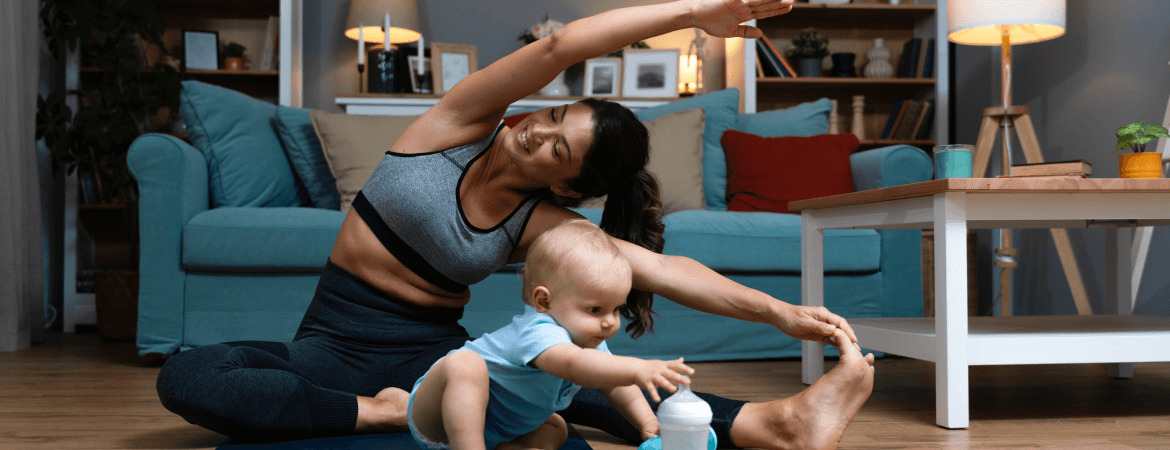
Postpartum fitness: Embracing your new body
How amazing is the human body? Imagine growing a whole baby for nine months, watching as your body swells to accommodate the little being – and then actually delivering the baby, too!
A pregnant body goes through incredible changes from conception to birth and well beyond. So, it’s important to keep this in mind when it comes to postpartum fitness.
How your body changes
During pregnancy, your body releases hormones like relaxin to prepare for childbirth. These hormones relax muscles and ligaments, making your joints more flexible. While this is essential for the birthing process, it can lead to increased joint instability and a need for focused postpartum strength training.
At the same time, your growing uterus can cause the abdominal muscles to separate, a condition known as diastasis recti. This can affect core strength and stability. Postpartum exercises should aim to gradually close the gap between the rectus abdominis muscles and strengthen the core.
The pelvic floor also goes through significant stress during pregnancy and childbirth. This can result in weakened pelvic floor muscles, leading to issues like urinary incontinence. Pelvic floor exercises become essential in postpartum fitness to improve strength and support.
Postpartum fitness
Taking all these changes into account, it’s easy to understand that your postpartum body isn’t immediately going to be raring and ready to hit the gym.
The immediate postpartum period, which refers to the first few weeks after giving birth, is a critical phase during which your body undergoes substantial physical and hormonal changes. You may feel a ton of varying emotions, struggle to adjust to the new demands of caring for a newborn, and just generally feel tired and out of sorts for a while. This is perfectly normal!
Expect to feel tired
Giving birth is an intense and physically demanding process. Your body expends a lot of energy during labour and delivery. As a result, many women feel a profound sense of fatigue in the immediate aftermath. This exhaustion is often linked to the potential length and intensity of labour, the method of delivery (vaginal or caesarean), and your overall health.
It’s okay to NOT immediately “bounce back”
Your muscles, ligaments and tissues in the pelvic region, abdomen and lower back have undergone substantial stress and stretching during childbirth. Soreness and discomfort are to be expected – both are normal for a while. Along with the general soreness, women who have had a vaginal delivery may experience perineal discomfort or stitches, while those who have undergone a Caesarean section may have incision pain.
So, with all this stress, please take it easy on your self-image and understand that it’s perfectly normal not to immediately snap back to pre-pregnancy size.
Start slow and aim for small progress
Your key mantra during this period should be: It’s a marathon, not a sprint (literally and figuratively)! Don’t start any fitness routine without first getting your doctor’s okay.
- Once you have the go-ahead, start with short, brisk walks as a low-impact way to increase circulation, improve your mood and gradually build up your strength.
- Pelvic floor exercises, such as Kegels, are essential for rebuilding strength and stability in the pelvic region. These exercises can help address issues like urinary incontinence, and support overall core function.
- Focus on diaphragmatic breathing to engage those deep abdominal muscles. This helps activate the core and supports the healing of the abdominal muscles post-pregnancy.
- Gentle postpartum yoga can enhance flexibility, improve posture, and promote relaxation. Look for classes for postpartum women and avoid poses that strain the abdominal muscles.
- Try bodyweight exercises to gradually rebuild strength. Squats, lunges and modified push-ups can be effective. Pay attention to proper form and take it nice and slow.
- Swimming is a low-impact, full-body workout that can be gentle on joints and muscles. Ensure that any incisions or stitches have fully healed before entering a pool.
Remember
Postpartum fitness is a personal journey, and everyone's recovery timeline is different. Be patient with yourself and celebrate small victories along the way.
Disclaimer
This article is for informational purposes only. Always check with your doctor or medical practitioner about any health concerns, before embarking on any fitness or nutrition programme, or using any medication.
